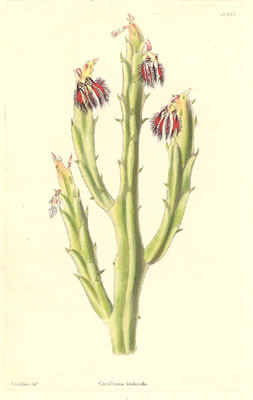Caralluma Caralluma fimbriata
- Common Names
- Botanical Name
- Caralluma fimbriata
- Family
- APOCYNACEAE
Medicinal Uses & Benefits of
![]() How to Use|
Side Effects |
Plant & Garden|
How to Use|
Side Effects |
Plant & Garden|
- Medicinal Uses: * African
* Ayurvedic
- Properties: * Appetite Depressant
- Parts Used: aerial parts
- Constituents: pregnane ester glycosides in the aerial parts and leaves of certain species. in addition to these compounds, fiber, proteins, lipids, fatty acids, and aromatic compounds.
How to Use: Caralluma
Caralluma spp is a succulent plant native to Asia, the Mediterranean, and Africa. Caralluma is eaten as a food and has a number of traditional ethnobotanical uses that include: diabetes, leprosy, rheumatism, paralysis, joint pain, migraines, fever, malaria, and inflammation. The species C. fimbriata and C. adscendens var. fimbriata have been used in traditional Indian medicine in this manner. In addition, C. tuberculata has been used as a digestive aid and to treat diabetes. Today most interest is centered on caralluma's use as an appetite suppressant. Caralluma works in much the same way as hoodia; both hoodia and caralluma contain preganane glycosides thought to aid in weight loss. 1
Preparation Methods & Dosage :Available in capsule and supplement form.
Caralluma Side Effects: Generally Recognized As Safe (GRAS) status.
Plant Description
Caralluma spp are a succulent plant native to Asia, the Mediterranean, and Africa.
- American Botanical Council
Despite traditional uses for weight loss, a double-blind, randomized, placebo-controlled trial on C. fimbriata (Slimaluna®; Gencor Nutrients; Anaheim, California) failed to yield any significant change in weight; however, this species was able to obtain Generally Recognized As Safe (GRAS) status. It is surmised that pregnane glycosides work in a similar way as garcinia (Garcinia cambogia), by preventing fatty acid biosynthesis











